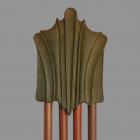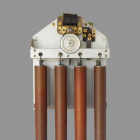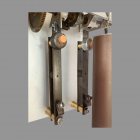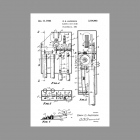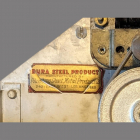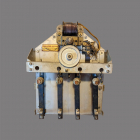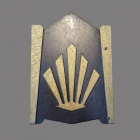Dura Steel Camshaft Westminster Door Chime 1934

Anderson Camshaft Door Chime 1934
This early cam-driven door chime was patented by Edwin G. Anderson. Manufactured by Dura Steel of Los Angeles, California in 1934. I can confirm very little about the inventor although an Edwin G. Anderson was a partner in a San Diego furniture store at that time.
Please contact the Doorbell Museum if you have additional information on this chime or Mr. Anderson.
Cam-driven door chimes are far less common than solenoid activated musical chimes. Cam-driven chimes play a single melody and thus can not provide separate calls for other doors or serve as remote servant calls for multiple rooms.
This chime is described in the patent claim as follows:
At approximately the central portion of the [casing] the camshaft is provided a worm gear which is engaged by a worm mounted on a counter shaft. Said counter shaft is supported by one extremity from an upward extension of the frame. This extension also supports a suitable pulley means operated by a motor.
The cam shaft also supports a[n electric] switch cam which is in the form of a circular disc with a notch therein… Said switch means comprises a suitably insulated base portion from which extends a a pair of leaf springs. Said leaf springs are provided with a suitable contact elements which are normally separated. One of the leaf springs is provided with an insulated cam rider portion which engages with the cam in such a manner that contact elements are separated, but when the rider engages the normal periphery of the cam said contact elements are engaged.
The stiker action on this early chime differs significantly from that used in the later cam-driven chimes described in the patent:
Each post supports a pair of upwardly extending leaf springs and which are arranged in substantial partial relation with each other and are separated by spacers, one at the extremities of the leaf springs. The leaf springs are space apart intermediate their ends by a cushion formed of rubber or the like. The leaf spring adjacent the chime tube is provided with a striker. Said striker is secured with the extended striker to the two springs. Said strike comprises a relatively heavy base portion in which is proved a socket adapted to receive as striker pad formed of leather or the like. (One) leaf spring projects slightly beyonds the (other) leaf spring and provided with an extremity which is turned in a direction away from the chime tube and is positioned so as the be engaged by the corresponding cam member. Each cam member is provided with one or more cam fingers…Teh cam members rotate in a direction to force the leaf springs away from the chime tubes and thereupon suddenly release the springs so that the striker engages the chime tube.
This example was mechanically restored for a 1936 home in Southern California.
| Manufacturer | Dura Steel. Patented by Edwin G. Anderson |
| Location of Manufacture | Los Angeles, California |
| Date of Manufacture | ~1934 |
| Cover | Painted Cast Zinc. |
| Mechanism | Plate Steel with brass gears and spring steel striker mechanisms. |
| Bells | Brushed Brass |
| Height | 60 inches |
| Width | 9 1/2 inches |
| Depth | 3 3/4 inches |
| Notes | Restored mechanism. Original patina on cover and bells. |
